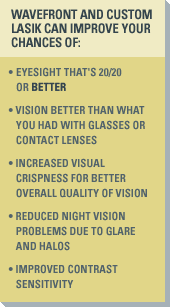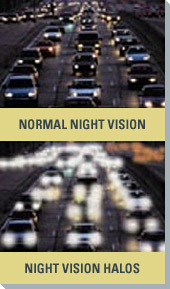|
|
 Custom LASIK -
Improving the Quality of Your Vision Custom LASIK -
Improving the Quality of Your Vision
Several types of visual imperfections, referred to as lower- and
higher-order aberrations, can exist within the eye and affect both visual
acuity and the quality of vision. Until now, only lower-order aberrations
(such as nearsightedness, farsightedness, and astigmatism) could be
measured and treated either with glasses or contacts or conventional LASIK
treatments. Higher-order aberrations, often linked to the visual glare and
halos that cause night vision problems, could not be corrected and
continued to affect quality of vision.
With the advent of Wavefront technology and Custom LASIK, however,
surgeons now have the diagnostic tools to measure 217 unique points along
the optical pathway to determine and ultimately correct both lower- and
higher-order aberrations. Using the precision provided by the WavePrint™
map, Custom LASIK has the potential to now not only correct how much you
see, but also how well you see.
|
 Who Can
Benefit From Wavefront LASIK? Who Can
Benefit From Wavefront LASIK?
Across the population as a whole, approximately 80% of refractive
errors are due to lower-order aberrations, such as nearsightedness,
farsightedness, and astigmatism. Higher-order aberrations are thought
to account for the remaining 20%. Those patients with a significant
amount of higher-order aberrations may not have satisfactory results
with conventional LASIK. A Wavefront guided laser eye surgery like
Wavefront LASIK may be the only way to treat their refractive errors.
There is also evidence that a customized Wavefront LASIK surgery can
yield crisper post-operative vision and reduce the chance of night
vision problems and glare - even in patients with low to moderate
amounts of higher-order aberrations. The best way to determine how a
customized procedure may benefit you is to have a comprehensive eye
evaluation and to obtain a WavePrint map of your own individual visual
"fingerprint."
 Are
There Additional Risks With Wavefront LASIK Compared To Conventional
LASIK? Are
There Additional Risks With Wavefront LASIK Compared To Conventional
LASIK?
Although all surgical procedures carry some risk, studies of Wavefront
technology and Custom LASIK have shown better results than
conventional LASIK. With this technological advance, more people now
qualify as candidates for laser vision correction, and conventional
candidates may achieve even better results. |
 |
|
 What
Results Have Been Achieved With Wavefront LASIK? What
Results Have Been Achieved With Wavefront LASIK?
Conventional LASIK has been, and continues to be, a very successful
procedure. All of our patients have improved vision, and almost 100%
of patients can legally drive a car without glasses or contact lenses.
Wavefront technology and Custom LASIK, however, have the potential to
make good results even better. A U.S. clinical trial using the Bausch
& Lomb Zyoptix system to treat myopia showed improved visual outcomes,
with a very large number of patients reporting being "very satisfied"
with their Wavefront guided LASIK surgery. In addition, a very high
percentage of patients reported reduced complications after surgery,
including improvement or no change in the areas of light sensitivity,
glare and night driving difficulties.
In addition, SCHWIND & CARRIAZO continues to make improvements in
vision technology. In December 2004, SCHWIND & CARRIAZO became the
first company to gain FDA approval for its wavefront guided treatment
for farsightedness with or without astigmatism. A six-month evaluation
of clinical study participants showed that 97.3% of farsighted
patients without astigmatism were corrected to 20/40 or better and
66.2% of patients were corrected to 20/20 or better - a 10% increase
over results with conventional LASIK! The evaluation also showed that
more than four times as many people were " very satisfied " with their
night vision after the procedure, compared to their night vision with
glasses and contacts before surgery. The SCHWIND & CARRIAZO clinical
study results exceeded all of the FDA required measurements for safety
and effectiveness.
|
 |
|



